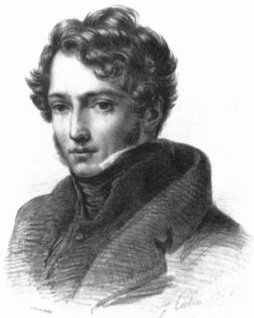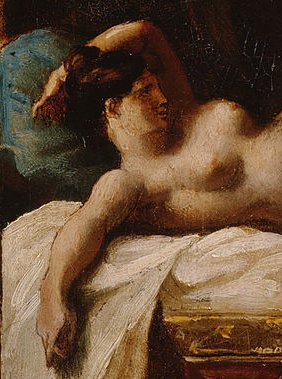
In the last few blogs I have talked about paintings which, at the time, shocked the establishment. In this blog I will be looking at a painting by one of the great French artists that, no doubt, would have shocked the nation of art lovers if it had ever been exhibited but in fact it only surfaced 170 years after its completion. The artist in question is Théodore Géricault, who is looked upon as one of the early leaders of the Romantic Movement and who went on to inspire another great artist of the Romantic Movement, Eugene Delacroix. The painting that probably would have astonished the art world, if it had been exhibited, was entitled Three Lovers and was completed around 1820 when Géricault was twenty-nine years of age. He must have been working on this painting at the same time that he was painting his great 1819 masterpiece The Raft of the Medusa (see My Daily Art Display of June 10th 2011).

Théodore Géricault was born in Rouen, France in September 1791. His family were of the upper middle class bracket. When Géricault was four years old the family moved from Rouen to Paris. He received the normal education as a child and teenager but showed little interest in his studies at the lycée. During his early life Géricault had two great passions in life – art and horses and loved to go horse riding a pastime which would literally be the death of him. When he was seventeen years of age his mother died and he received a sizeable inheritance.
In 1808, aged seventeen years of age, he enrolled at the studio of Carle Vernet, who was best known for his paintings of horses. Two years later, in 1810, he moved to the studio of Pierre-Narcisse Guérin, a much admired classical painter where he received a much enhanced academic training in art. After just six months working with Guérin, Géricault left the studio to concentrate on copying the great works housed at the Louvre. He did this for three years.

In 1812 he entered a painting into the Salon. It was originally entitled Equestrian Portrait of M.D***, later to be changed to The Charging Chasseur. It was a depiction of a mounted Napoleonic cavalry officer who is ready to attack the enemy. The chasseur sits astride his grey stallion, sword in hand, raring to go into battle. The horse, with flying mane and foaming mouth, enforces the animal’s aggressive passion. This was a true war-horse. This was what was good about war – bravery of man and animal and ultimate victory. The painting met with critical acclaim. Everybody loves a winner !

Two years later, in 1814, buoyed by this success, Géricault once again exhibited The Charging Chasseur along with a newly completed work at that year’s Salon, entitled The Wounded Cuirassier leaving the field of Battle but to his amazement and annoyance the art critics were critical and the public were dismissive of his effort. So, why the change of heart amongst the critics and the public? Géricault loved the subject of horses and horsemanship and during the Napoleonic era such subject matter proved irresistible to him and the French public. For Géricault, his love was to depict the powerful combination of a rider dressed in his magnificent uniform and the sheer animal power of his horse. However, this was not the normal depiction seen in academic battle paintings where the artist focused on a mass of soldiers led into battle by a famous general. These were paintings depicting victorious battles. However, in The Wounded Cuirassier leaving the field of Battle we see a depiction of a single anonymous wounded soldier with his battle-weary mount limping from the battlefield. This was definitely not what the establishment and the art critics wanted to see. Maybe Géricault’s biographer, the nineteenth century art historian, Charles Clément, summed it up perfectly when he wrote of the difference between the two works:
“…In 1812 success was still in the air, whilst in 1814 everyone knew they were facing defeat…….The echoes of the cries of distress from our suffering armies on the plains of Russia resounded through the lands. Hearts were full of fear and terror. It is this universal feeling which Géricault expressed in his painting and explored in the Wounded Cuirassier…..He painted two pictures, the first about glory and the other about faded glory…”
In 1816 with a desire to win a three-year paid scholarship in Rome he competed for the Prix de Rome. However his work just got him to the semi final stage before his offering was eliminated. Still with a desire to go to Italy he decided to fund himself. He stayed in Italy visiting Florence, Rome and Naples before returning to Paris a year later. It was during this period in Paris (1818-19) that he set about painting his famous work The Raft of the Medusa. This was an enormous work of art which measured approximately 4.9m x 7.2m (16ft x 23ft). It was also during this time that he decided to paint, for himself, a small highly erotic work entitled Three Lovers.

Three Lovers which is now housed in the Paul Getty Museum in Santa Monica measured just 22.5cms x 29.8cms (9 inches x 12 inches). The picture is dominated by a large bed that is framed by furniture and a large curtain which is partly drawn to the side. In some ways it is as if we were theatre-goers and we are looking at a stage with the theatre curtain pulled to one side for us to enjoy the performance, and what a performance!

At one end of the bed we see a dark haired woman lying somewhat lethargically against some blue pillows. She is naked from the waist up and her arms are spread wide exposing her rounded breasts. She looks closely at a pair of lovers who are making love. By her expression we feel that she is sated, probably having already had her turn of lovemaking with the man who is now pleasuring himself with the blonde woman at the opposite end of the bed. She is now happy to watch as the pair make love. She has now taken on the role as voyeur. The blonde and the man are locked in an intimate embrace. She half kneels on the bed between his thighs. Although he is almost hidden from view his naked legs would suggest he is lying semi-naked beneath his lover. The blonde woman is not naked but her white dress is pulled up to her waist by the man’s encircling arm which exposes her naked thigh and buttock. The way in which she has positioned herself on top of the man and the way she has her arms tightly wrapped around his neck exhibits her obvious arousal.

Géricault has depicted the blonde woman’s stocking down at her ankle which adds to the erotic nature of the painting.
It is a highly erotic work of art and because of the nature of the depiction Géricault would almost certainly have painted it for himself. He would never have intended it to be exhibited as he would have known full well that it would have been condemned by both critics and public for its dubious morality in a society which strongly adhered to religious and moral values and which condemned sexual excesses and misbehaviour. Of course having said all that it could well be that such erotic encounters did take place between prostitutes and their customers despite people pretending such excesses did not occur. Maybe Géricault was reminding himself of what did happen in dimly lit rooms where passions prevailed over civic respectability.

Nice review, thanks